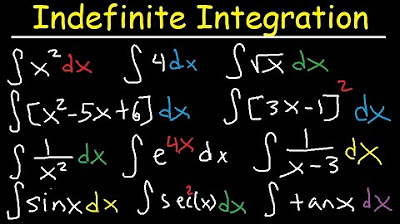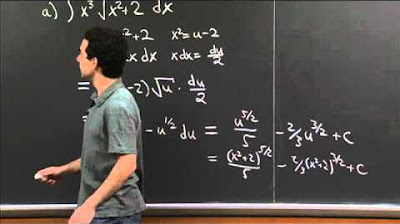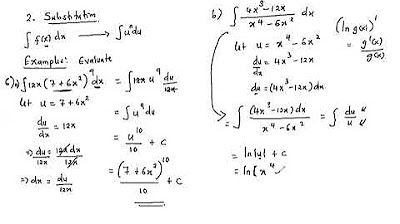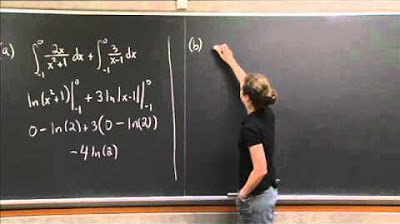Calculus 2 Final Exam Review -
TLDRThis comprehensive calculus video tutorial covers a range of integral calculus problems, focusing on techniques such as integration by parts, trigonometric integrals, and trigonometric substitution. The video begins with solving an indefinite integral using integration by parts, followed by a discussion on trigonometric integrals and their solutions using u-substitution. It then delves into the application of trigonometric substitution to find the indefinite integral of a function involving x squared plus 9. The video also addresses partial fractions, improper integrals, and their convergence or divergence. Practical applications are explored through the use of the trapezoidal rule to estimate work done by a force and Simpson's rule to estimate displacement. The tutorial concludes with calculating arc length and surface area, providing a solid foundation for students preparing for Calculus II final exams.
Takeaways
- 📚 **Integration by Parts**: The video begins with an example of using integration by parts to find the indefinite integral of a product of functions, specifically x^2 sin(x) dx.
- 🔁 **Repeated Integration by Parts**: It demonstrates the need to apply integration by parts more than once for certain integrals, adjusting the choice of 'u' and 'dv' accordingly.
- 📈 **Trigonometric Integrals**: The technique of substitution is introduced for evaluating more complex trigonometric integrals, like cos^5(x) dx, by converting them into a form that allows for easier integration.
- 🔢 **Trigonometric Substitution**: The video shows how to use trigonometric substitution to solve integrals that involve expressions like x^2 + 9, by choosing the appropriate trigonometric function to set equal to 'x'.
- 📐 **Right Triangle and Pythagorean Theorem**: The Pythagorean theorem is applied within a right triangle context to find the hypotenuse and subsequently secant and cosine in terms of 'x'.
- ✅ **Partial Fractions**: The method of partial fractions is explained for decomposing rational functions into simpler fractions to facilitate integration, with an example of x/(x^2 - 4).
- 🔍 **Improper Integrals**: The concept of improper integrals is discussed, with a demonstration of how to determine if they converge or diverge using limits.
- 🔌 **Work Done by a Force**: The trapezoidal rule is applied to estimate the work done by a force over a displacement, using a table of force values at different positions.
- 🏃 **Displacement Estimation**: Simpson's rule is introduced for estimating the displacement of an object over time, given a table of velocity values.
- 🛤️ **Arc Length Calculation**: The formula for calculating the arc length of a function is presented, using the square root of the sum of the function's derivative squared plus one.
- 🎢 **Surface Area of a Curve**: The video concludes with finding the surface area generated by rotating a curve around the x-axis, using a formula that involves the function, its derivative, and the constant pi.
Q & A
What is the technique used to find the indefinite integral of x^2 * sin(x) dx?
-Integration by parts is used to find the indefinite integral of x^2 * sin(x) dx. The formula used is ∫udv = uv - ∫vdu.
How do you choose u and dv for the integration by parts of x^2 * sin(x) dx?
-For integration by parts, u is chosen as x^2 and dv as sin(x) dx. This leads to du being 2x dx and v as the antiderivative of sin(x), which is -cos(x).
What is the antiderivative of sin(x) with respect to x?
-The antiderivative of sin(x) is -cos(x), since the derivative of cos(x) is -sin(x).
How many times is the integration by parts performed in the solution of x^2 * sin(x) dx?
-The integration by parts is performed twice to solve for the indefinite integral of x^2 * sin(x) dx.
What trigonometric identity is used to rewrite cos^5(x) in the second example?
-The trigonometric identity used is cos^2(x) = 1 - sin^2(x), which is applied to rewrite cos^5(x) as cos(x) * cos^4(x) and then cos^4(x) as (cos^2(x))^2.
What substitution is used to solve the integral involving sin^4(x) * cos(x) dx?
-The substitution u = sin(x) is used, which leads to du = cos(x) dx, allowing us to replace all instances of cos(x) dx with du in the integral.
What is the final answer for the indefinite integral of x^2 * sin(x) dx using integration by parts?
-The final answer is -x^2 * cos(x) + 2x * sin(x) + 2 * cos(x) + C, where C is the constant of integration.
What is the method used to find the indefinite integral of a trigonometric integral such as the one in the second example?
-U-substitution is used to find the indefinite integral of the given trigonometric integral. The method involves substituting a variable u for a part of the integral and then simplifying the integral in terms of u.
What is the process for finding the indefinite integral of a function using trigonometric substitution?
-The process involves choosing an appropriate trigonometric function to substitute based on the form of the integral (e.g., sine, tangent, or secant), then using the derivatives of these trigonometric functions to express the integral in terms of the new variable, and finally integrating with respect to the new variable.
What is the formula for the arc length of a function from a to b?
-The formula for the arc length of a function from a to b is ∫[a, b] √(1 + (f'(x))^2) dx, where f'(x) is the derivative of the function f(x).
How is the work done by a force on an object estimated when the force is variable?
-The work done by a variable force on an object is estimated by calculating the definite integral of the force function with respect to displacement times dx.
What is the trapezoidal rule used for in the context of the provided script?
-In the script, the trapezoidal rule is used to estimate the work done by a force over a variable displacement, by summing the areas of trapezoids under the force-displacement curve.
What is the formula for Simpson's rule?
-Simpson's rule is a method for numerical integration, and the formula used in the script is (Δx/3) * [f(x₀) + 4f(x₁) + 2f(x₂) + 4f(x₃) + 2f(x₄) + 4f(x₅) + f(x₆)].
How is the instantaneous velocity used to estimate the displacement of an object?
-The instantaneous velocity is used to estimate the displacement of an object by applying Simpson's rule to the integral of the velocity function over time.
What is the formula for calculating the surface area obtained by rotating a curve about the x-axis?
-The formula for calculating the surface area obtained by rotating the curve f(x) about the x-axis from a to b is ∫[a, b] 2π * f(x) * √(1 + (f'(x))^2) dx.
Outlines
📚 Calculus II Final Exam Preparation: Integration by Parts
This paragraph introduces the video's purpose, which is to assist students studying for their Calculus II final. It begins with a problem involving finding the indefinite integral of x squared sine x, using the technique of integration by parts. The process is explained step-by-step, emphasizing the formula for integration by parts and its application. The solution involves making appropriate choices for u and dv, and performing the integration twice due to the complexity of the integral. The final answer is presented clearly, showcasing the use of integration by parts in solving calculus problems.
🧮 Trigonometric Integrals and U-Substitution
The second paragraph deals with finding the indefinite integral of cosine to the fifth power. The trigonometric identity sine squared plus cosine squared equals one is used to rewrite the integral in terms of sine. U-substitution is then introduced as the method to solve the integral. The substitution is performed by setting u equal to sine x, which allows for the integration to be simplified and solved using the power rule. The final answer is expressed in terms of sine to various powers, demonstrating the use of u-substitution in trigonometric integrals.
📐 Trigonometric Substitution for Complex Integrals
The third paragraph focuses on a trigonometric substitution problem involving x squared plus 9. The choice of substitution is explained based on the form of the expression, and tangent is chosen due to its relationship with secant squared. The substitution is carried out by expressing x in terms of tangent theta and dx in terms of secant squared theta d theta. The integral is then simplified and solved using another substitution, resulting in an expression involving secant theta. The process illustrates the use of trigonometric substitution in solving more complex integrals.
🔍 Finding the Indefinite Integral Using Trigonometric Substitution
In this paragraph, the focus is on finding the indefinite integral of a function involving x squared plus 9. The process involves trigonometric substitution, where x is expressed as 3 tangent theta. A right triangle is used to find the relationship between tangent theta, secant theta, and x. The integral is then solved by substituting secant theta with an expression involving x, and simplifying the resulting expression to find the final answer in terms of x. This demonstrates the application of trigonometric identities and the Pythagorean theorem in integral calculus.
📝 Solving Improper Integrals and Partial Fractions
The fifth paragraph discusses the process of finding the indefinite integral of a rational function using partial fractions. The function's denominator is factored, and the integral is broken down into simpler parts. The values of a, b, and c in the partial fraction decomposition are determined by plugging in specific x values. The indefinite integral is then found by integrating each term and combining the results. The paragraph concludes with a method to determine if an improper integral converges or diverges, using limits to evaluate the integral.
🔢 Estimating Work Done Using the Trapezoidal Rule
This paragraph presents the use of the trapezoidal rule to estimate the work done by a force over a displacement. The work is defined as the integral of the force function, and the trapezoidal rule is applied to estimate this integral. The formula for the trapezoidal rule is provided, and the process is demonstrated using a table of force values at different displacements. The final answer is an approximation of the work done, calculated using the given force values and the width of each interval.
📏 Estimating Displacement Using Simpson's Rule
The seventh paragraph covers the use of Simpson's rule to estimate the displacement of an object over a period of time. Displacement is calculated as the integral of the velocity function, and Simpson's rule is used to approximate this integral. The formula for Simpson's rule is given, and the process is illustrated using a table of velocity values at different time intervals. The final answer is an approximation of the displacement in feet, calculated using the provided velocity values.
🌀 Calculating Arc Length with Definite Integrals
The eighth paragraph focuses on finding the arc length of a given function. The arc length is calculated using the definite integral of the square root of 1 plus the square of the first derivative of the function. The first derivative is found using the chain rule, and the integral is evaluated from 0 to 4. The process involves u-substitution to simplify the integral, and the final arc length is given as an exact value and a decimal approximation.
🎢 Surface Area of a Curve Rotated Around the x-Axis
The final paragraph addresses the calculation of the surface area obtained by rotating the curve f(x) = x cubed from 0 to 2 around the x-axis. The formula for the surface area involves the definite integral of 2 pi times the function value times the square root of 1 plus the square of the first derivative. The first derivative of the function is found, and the integral is evaluated using u-substitution. The limits of integration are adjusted accordingly, and the final surface area is given as an exact value and a decimal approximation.
Mindmap
Keywords
💡Integration by parts
💡Anti-derivative
💡Trigonometric integral
💡U-substitution
💡Trigonometric substitution
💡Partial fractions
💡Improper integral
💡Trapezoidal rule
💡Simpson's rule
💡Arc length
💡Surface area
Highlights
Integration by parts is used to find the indefinite integral of x squared sine x dx.
The antiderivative of sine is negative cosine x, derived from the derivative of negative cosine being positive sine.
After applying integration by parts twice, the final answer for the integral involves negative x squared cosine x plus terms involving x sine x and cosine x, plus a constant of integration.
Trigonometric integrals can be solved using u-substitution, as demonstrated with the integral of cosine to the fifth power.
The antiderivative of sine is found using the power rule for integration, resulting in terms involving sine to various powers.
Trigonometric substitution is applied to an integral involving x squared plus 9, using tangent due to the form of the expression.
The Pythagorean theorem and trigonometric identities are used to express the integral in terms of secant theta, leading to the final integral expression.
Another substitution is used to simplify the integral further, resulting in an expression involving u squared minus one, which is then integrated.
Partial fractions are used to solve an integral where the degree of the denominator is higher than the numerator, factoring the denominator and solving for the constants a, b, and c.
The improper integral is evaluated to determine if it converges or diverges, using limits and finding a finite value indicates convergence.
The trapezoidal rule is used to estimate the work done by a force over a displacement, using a series of force values and the width of each interval.
Simpson's rule is applied to estimate the displacement of an object given its instantaneous velocity over time, using a formula that weights the velocity values differently.
The arc length of a function is calculated using the definite integral from a to b of the square root of 1 plus the square of the first derivative, with u-substitution simplifying the integral.
The surface area obtained by rotating a curve about the x-axis is found using a formula involving 2 pi, the function value, and the square root of 1 plus the square of its derivative, again using u-substitution for simplification.
The use of trigonometric identities and the Pythagorean theorem are crucial in converting trigonometric expressions into a more manageable form for integration.
The method of u-substitution is a powerful technique for converting complicated integrals into simpler forms that can be more easily solved.
Numerical methods like the trapezoidal and Simpson's rules provide approximations for definite integrals, useful when exact solutions are difficult to obtain.
Transcripts
Browse More Related Video

Indefinite Integral - Basic Integration Rules, Problems, Formulas, Trig Functions, Calculus

Integration Practice III | MIT 18.01SC Single Variable Calculus, Fall 2010

ALL OF Calculus 2 in a nutshell.

Calculus 2 - Basic Integration

Integration using substitution method

Integration Practice I | MIT 18.01SC Single Variable Calculus, Fall 2010
5.0 / 5 (0 votes)
Thanks for rating: